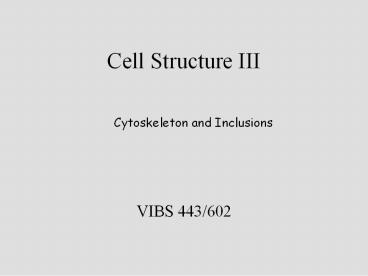Cell Structure III - PowerPoint PPT Presentation
1 / 37
Title:
Cell Structure III
Description:
Cell Structure III Cytoskeleton and Inclusions VIBS 443/602 Opened Interclated disc in cardiac cells of Heart, endocardium 226 Lipofuscin in cardiac cells of Heart ... – PowerPoint PPT presentation
Number of Views:175
Avg rating:3.0/5.0
Title: Cell Structure III
1
Cell Structure III
Cytoskeleton and Inclusions
- VIBS 443/602
2
CYTOSKELETON
- MICROTUBULES (25 nM)
- MICROFILAMENT (6 nM)
- INTERMEDIATE FILAMENT (10 nM)
3
EM 4 liquid droplets are sometimes clustered
together in irregularly shaped groups visible in
intestinal epithelial cells. Note the large
droplets visible in the goblet cell contain
mucin, not lipid. 1. Lipid 2. Chylomicrons 3.
Mucus
4
EM 4 (Enlargement of section from class print)
Microvilli at apical ends of intestinal
absorptive cells with parallel arrays of
microfilaments in their cores. The microvilli are
covered with a wispy glycocalyx. The terminal web
region immediately below the microvilli contains
a very high concentration of microfilaments and
(keratin) intermediate filaments, and thereby
excludes most other cell organelles. 1.
Microvilli 2. Glycocalyx 3. Terminal web
5
EM 4b intestinal absorptive cell (apex)
60,000x 1. Microfilaments 2. Microvilli 3.
Mitochondria 4. Plasma membranes of adjacent
cells 5. Terminal web 6. Zonula occludens
6
EM 2b Liver cytoskeleton elements.
Microtubules, microfilaments, and intermediate
filaments can be compared in this cell, which has
a high concentration of cortical
microfilaments. 1. Microtubule 2.
Microfilaments 3. Intermediate filaments
7
EM 19c
8
EM 6a Insect spermatocyte. Centriolar region of
a cell showing both the stable, triplet
microtubule arrays within the centriole, and the
labile, individual microtubules originating from
pericentiolar material. 1. Centriole 2. Stable
microtubule 3. Labile microtubule
9
EM 6b monkey oviduct cross-sectional view of
cilia and basal bodies. 1. Basal bodies 2.
Cilia 3. Axoneme
10
EM 6c monkey oviduct longitudinal section
through basal bodies and cilia. Basal body
microtubules serve as assembly sites for outer
doublet microtubules that are continuous with
them. This is not true for the central pair of
microtubules. 1. Basal body 2. Axoneme 3. Cilia
11
EM 2b
12
EM 10d peripheral nerve Schwann cells and
axons. Neurofilaments (intermediate filaments)
and microtubules can be seen in both myelineated
and unmyelineated axons. 1 Neurofilaments 2
Microtubule
13
EM 10c
14
CELL COMPOSITION
- THREE MAJOR CLASSES OF
- CYTOPLASMIC STRUCTURE
- -------------------------------------------------
- 1. MEMBRANOUS ORGANELLES
- 2. NON-MEMBRANOUS ORGANELLES CYTOSKELETAL
COMPONENTS etc - 3. INCLUSIONS - EXPENDABLES
15
- INCLUSIONS - EXPENDABLES
- a. NUTRIENT e.g., GLYCOGEN, LIPID
- b. PIGMENT e.g., MELANIN GRANULES
- c. SECRETORY GRANULE e.g., ZYMOGEN GRANULE OF
PANCREAS
16
EM 2 liver. Glycogen appears as darkly staining,
granular structures that are slightly larger than
a ribosome. 1. Glycogen 2. Ribosome 3. Golgi
vesicle 4. Lipid
17
EM 25 ovary. Yolk protein has formed a
crystalloid inclusion within the cytoplasm of
this oocyte. 1. Crystalloid inclusion
18
EM 24 corpus luteum. Several clear, non-membrane
bounded lipid droplets are visible in the
cytoplasm of the large cell. 1. Lipid
droplets 2. Mitochondria 3. Smooth endoplasmic
reticulum 4. Rough endoplasmic reticulum
19
(No Transcript)
20
Slide 156 MonkeyPancreas toulidine blue 1.
Islet 2. Pancreatic acinar cells
21
Pancreas, monkey (toluidine blue)
156
22
EM 1 pancreas. Secretory droplets containing
digestive enzymes are major constituents of
pancreatic acinar cells. 1. Zymogen granules 2.
Rough endoplasmic reticulum 3. lumen
23
EM 4
Secretory droplets
24
EM 14 stomach. Secretory droplets with a variety
of sizes and staining intensities are visible. 1.
Secretory granules 2. Secretory vacuoles 3. Rough
endoplasmic reticulum
25
EM 4c Intestinal absorptive cell (super nuclear
region) 60,000x. 1. Budding RER 2. Coated
vesicle 3. Golgi 4. Mitochondria 5. Nucleus 6.
Plasma membrane 7. Primary lysosome
26
EM 20 testis. Several darkly staining lipofuscin
granules representing indigestible material are
visible in this steroid-secreting cell. 1.
Lipofuscin granule 2. Nucleus 3. Mitochondrion
27
Lung
28
432 lung with bronchi
29
432 lung with bronchi
30
- EM 8h Macrophage in testis 30,000x.
- Enlarged basal lamina
- Heterophagic vacuole
- Leydig cell cytoplasm
- Nucleolus
- Myoid cell
31
EM 19c
Lipid droplets
32
EM 21 Ductus deferens 11,000x. 1. Golgi 2.
Stereocilia 3. Mitochondria 4. Swirl of SER
33
(No Transcript)
34
Opened Interclated disc in cardiac cells of
Heart, endocardium
226
35
Lipofuscin in cardiac cells of Heart
226
36
146
492
37
Peripheral ganglion, monkey
492































